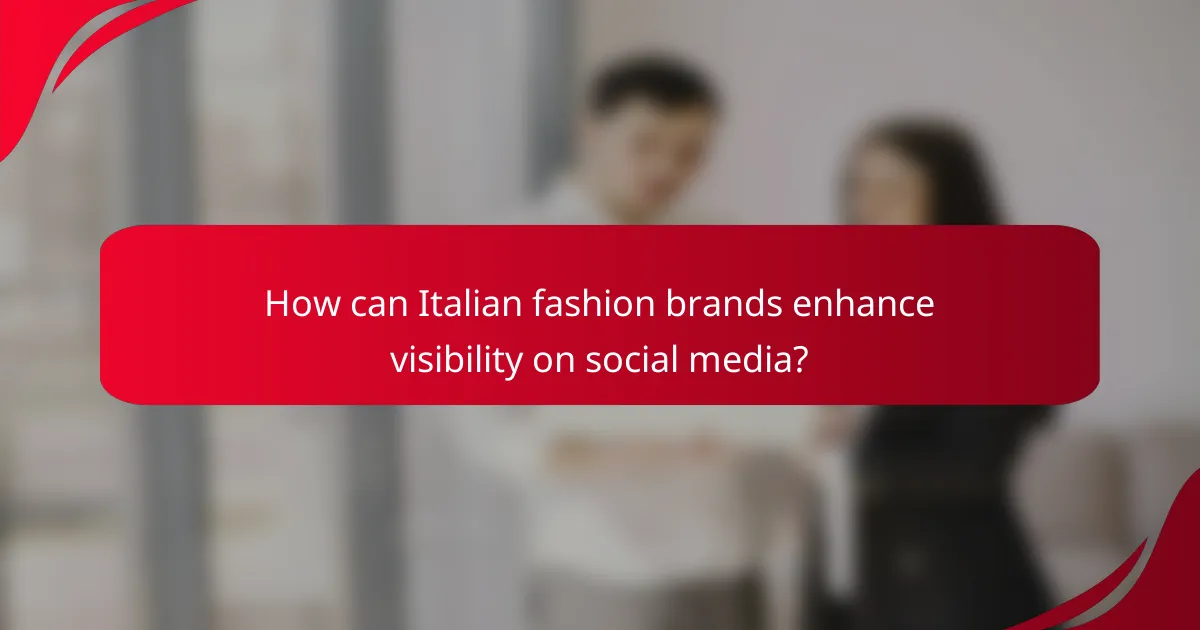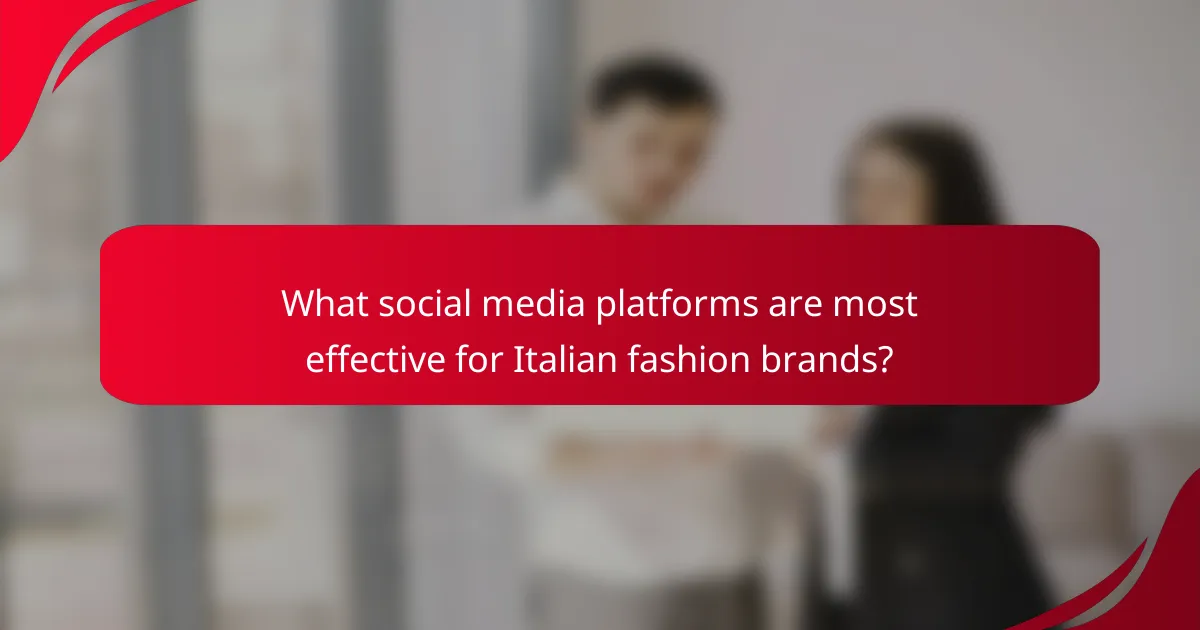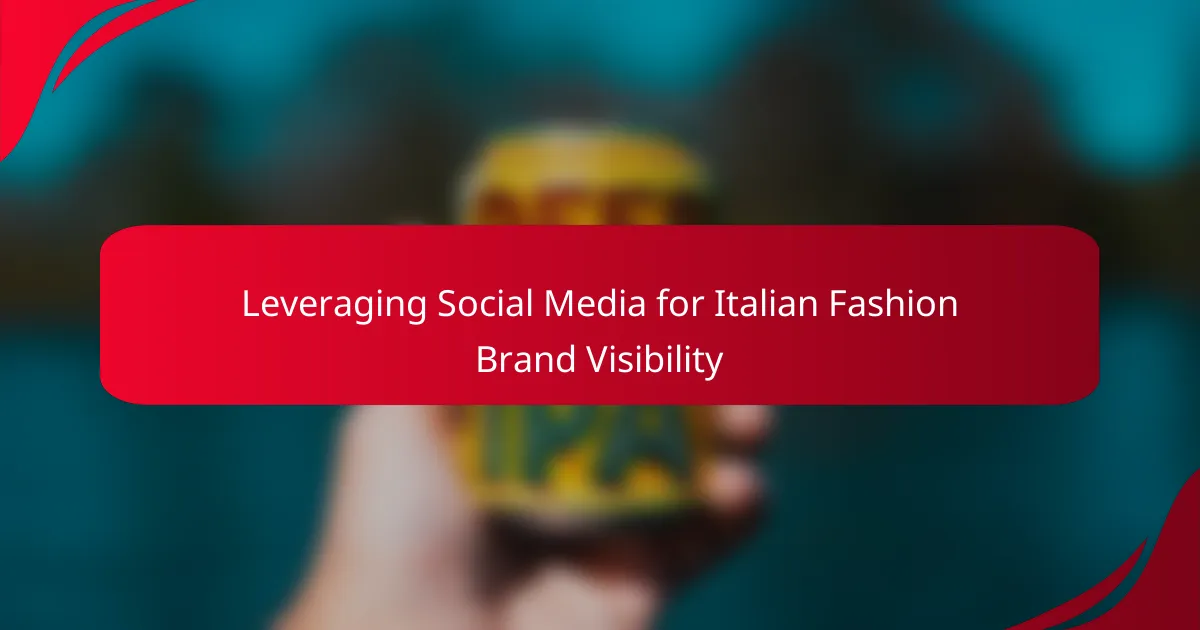In today’s digital landscape, Italian fashion brands can significantly boost their visibility by effectively utilizing social media platforms such as Instagram and TikTok. By engaging with influencers and creating visually captivating content, these brands can forge meaningful connections with their audience and cultivate a robust online presence. Emphasizing interactive and community-driven strategies further enhances audience engagement, fostering loyalty and participation among followers.

How can Italian fashion brands enhance visibility on social media?
Italian fashion brands can enhance their visibility on social media by strategically leveraging platforms like Instagram, engaging with influencers, and creating captivating content. These approaches help brands connect with their audience and build a strong online presence.
Utilizing Instagram for brand storytelling
Instagram is a powerful platform for Italian fashion brands to tell their stories visually. By sharing behind-the-scenes content, brand history, and the inspiration behind collections, brands can create a narrative that resonates with their audience.
Utilize features like Stories and Reels to showcase products in action, highlight customer experiences, and engage followers through polls or Q&A sessions. Consistent posting and a cohesive aesthetic are key to maintaining audience interest.
Engaging influencers in the fashion niche
Collaborating with influencers can significantly boost visibility for Italian fashion brands. Influencers with a strong following in the fashion niche can introduce the brand to new audiences and lend credibility.
When selecting influencers, consider their engagement rates and alignment with the brand’s values. Micro-influencers, who often have more engaged audiences, can be particularly effective for targeted campaigns.
Creating visually appealing content
High-quality visuals are essential for capturing attention on social media. Italian fashion brands should invest in professional photography and videography to showcase their products in the best light.
Utilize a mix of lifestyle images, product shots, and videos that highlight the craftsmanship and details of the clothing. Consistency in style and color palette can help create a recognizable brand identity.
Leveraging user-generated content
User-generated content (UGC) is a valuable asset for Italian fashion brands. Encouraging customers to share their own photos wearing the brand can create authentic engagement and build community.
Brands can incentivize UGC through contests or by featuring customer photos on their official pages. This not only provides social proof but also fosters a sense of loyalty among customers.
Implementing targeted advertising campaigns
Targeted advertising on platforms like Facebook and Instagram allows Italian fashion brands to reach specific demographics effectively. By defining target audiences based on interests, behaviors, and location, brands can maximize their ad spend.
Consider using eye-catching visuals and clear calls to action in ads. Regularly analyze campaign performance to optimize strategies and ensure the best return on investment.

What social media platforms are most effective for Italian fashion brands?
Italian fashion brands find the most success on platforms like Instagram, Facebook, Pinterest, and TikTok. Each platform serves distinct purposes, from showcasing visual content to building communities and reaching younger demographics.
Instagram as a visual platform
Instagram is the premier platform for Italian fashion brands due to its focus on visual storytelling. High-quality images and videos can showcase products, highlight brand aesthetics, and engage followers through captivating content.
Brands should utilize features like Stories and Reels to share behind-the-scenes glimpses and fashion tips. Consistent posting and engaging with followers through comments can enhance brand visibility and loyalty.
Facebook for community building
Facebook excels in fostering community and interaction among fans of Italian fashion brands. Brands can create dedicated groups or pages to share updates, host discussions, and gather feedback from their audience.
Utilizing Facebook Events for product launches or fashion shows can also drive engagement. Brands should encourage user-generated content by inviting customers to share their own experiences and photos, creating a sense of belonging.
Pinterest for inspiration and trends
Pinterest serves as a powerful tool for Italian fashion brands to inspire potential customers and showcase trends. By creating visually appealing boards, brands can curate collections that reflect seasonal styles or specific themes.
Brands should optimize their pins with keywords and links to their websites, driving traffic and increasing sales. Regularly updating boards with fresh content can keep followers engaged and attract new users searching for fashion ideas.
TikTok for reaching younger audiences
TikTok is essential for Italian fashion brands aiming to connect with younger audiences. The platform’s short-form video format allows brands to create fun, engaging content that can go viral quickly.
Brands should leverage trending challenges and hashtags to increase visibility. Collaborating with influencers on TikTok can also amplify reach and introduce the brand to new potential customers, making it a vital part of a modern marketing strategy.

What strategies can improve audience engagement?
To enhance audience engagement for an Italian fashion brand, focus on interactive and community-driven strategies. These methods foster a deeper connection with your audience, encouraging participation and loyalty.
Hosting live fashion events
Live fashion events create a dynamic platform for direct interaction with your audience. Consider hosting virtual runway shows or Q&A sessions with designers, which can be streamed on platforms like Instagram or Facebook Live.
Promote these events in advance to build anticipation, and encourage viewers to ask questions or share their thoughts in real-time. This not only boosts engagement but also provides valuable feedback on your collections.
Running interactive polls and contests
Interactive polls and contests are effective tools for engaging your audience and gathering insights. Use social media stories to create polls about upcoming designs or color preferences, allowing followers to influence your brand’s direction.
Contests can also drive participation; for example, encourage users to share photos wearing your brand with a specific hashtag for a chance to win a gift card or exclusive items. This not only increases engagement but also expands your brand’s reach through user-generated content.
Collaborating with local artists
Partnering with local artists can enhance your brand’s visibility and authenticity. Collaborations can take the form of limited-edition pieces or unique artwork that resonates with your audience’s cultural context.
Highlight these partnerships on social media, showcasing the creative process and the stories behind the collaborations. This approach not only engages your audience but also strengthens community ties, making your brand more relatable and appealing.

What metrics should Italian fashion brands track for success?
Italian fashion brands should focus on key metrics such as engagement rate, follower growth, and conversion rates to gauge their success on social media. Tracking these metrics helps brands understand their audience’s behavior and the effectiveness of their marketing strategies.
Engagement rate on posts
The engagement rate measures how actively users interact with a brand’s content, including likes, comments, shares, and saves. For Italian fashion brands, a healthy engagement rate typically ranges from 1% to 5%, depending on the platform and audience size.
To improve engagement, brands should create visually appealing content that resonates with their target audience. Regularly analyzing which posts receive the most interaction can help refine content strategies and enhance audience connection.
Follower growth over time
Follower growth indicates how effectively a brand is attracting new audiences. Consistent growth, ideally in the range of 5% to 10% monthly, suggests that the brand is successfully expanding its reach and visibility.
To foster follower growth, Italian fashion brands should leverage collaborations with influencers, run targeted campaigns, and engage with their community through comments and messages. Monitoring follower trends can also help identify successful strategies and areas needing improvement.
Conversion rates from social ads
Conversion rates from social ads reflect the percentage of users who take a desired action after interacting with an advertisement, such as making a purchase or signing up for a newsletter. A good conversion rate for social media ads typically falls between 1% and 3% for fashion brands.
To enhance conversion rates, brands should ensure their ads are visually striking and clearly communicate value. A/B testing different ad formats and targeting options can help identify the most effective approaches for driving sales and engagement.

How can brands adapt their strategies for different markets?
Brands can adapt their strategies for different markets by understanding local consumer preferences, cultural nuances, and market dynamics. Tailoring marketing efforts to resonate with specific audiences is crucial for enhancing brand visibility and engagement.
Understanding local consumer preferences
To effectively reach consumers, brands must research and analyze local tastes, trends, and purchasing behaviors. For instance, Italian fashion may emphasize craftsmanship and heritage in Europe, while in Asia, there might be a stronger focus on modernity and innovation.
Conducting surveys or focus groups can provide insights into what local consumers value in fashion, whether it’s sustainability, luxury, or affordability. Brands should also monitor social media trends to stay updated on evolving preferences.
Cultural nuances and sensitivities
Each market has its own cultural context that influences consumer behavior. Brands should be aware of local customs, holidays, and social norms when crafting their messaging. For example, promotional campaigns during Italian fashion weeks may resonate well in Europe but could be less effective in markets where fashion events differ.
Adapting visuals and language to reflect local culture can enhance relatability. Collaborating with local influencers who understand the market can also help navigate cultural sensitivities and foster authenticity.
Market dynamics and competition
Understanding the competitive landscape is essential for adapting strategies. Brands should analyze local competitors, their pricing strategies, and marketing tactics. This can help identify gaps in the market and opportunities for differentiation.
For example, if a brand notices that competitors focus heavily on online sales in a particular region, it might consider enhancing its e-commerce platform or offering exclusive online collections to capture market share.
Tailoring marketing channels
Different markets may favor various marketing channels. In Italy, traditional media like fashion magazines may still hold sway, while in other regions, social media platforms like Instagram or TikTok could be more effective. Brands should evaluate which channels are most popular among their target demographics.
Additionally, leveraging local social media influencers can amplify brand messages and create a more personalized connection with consumers. Brands should also consider localized content that speaks directly to the audience’s interests and values.










